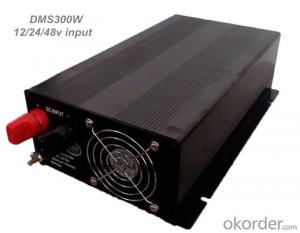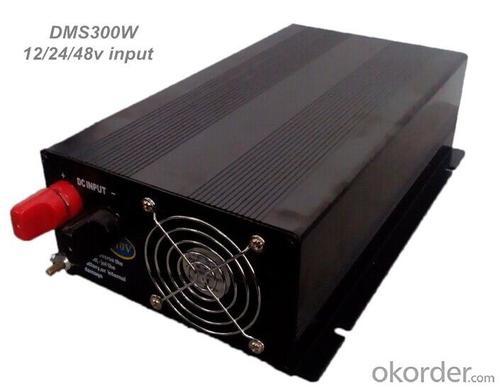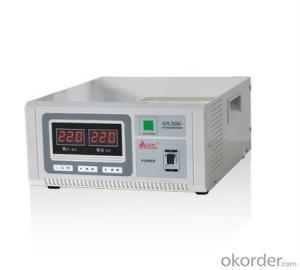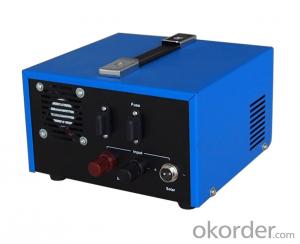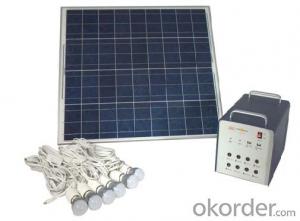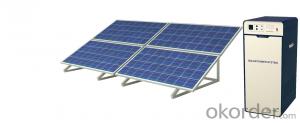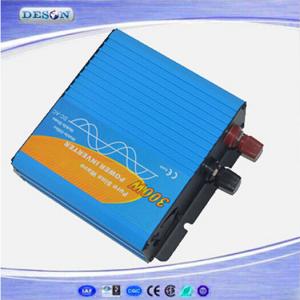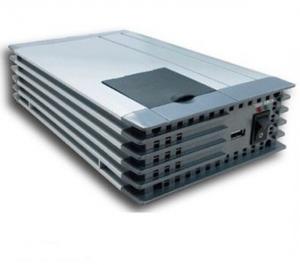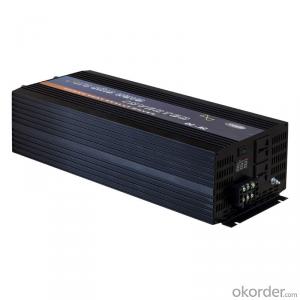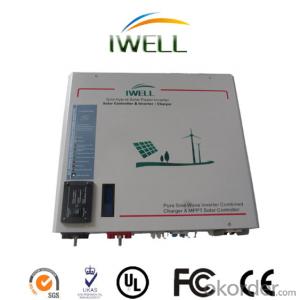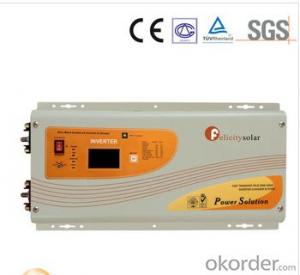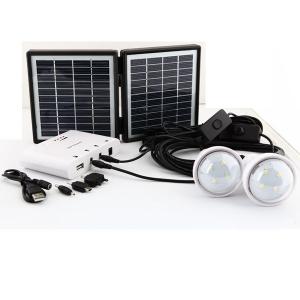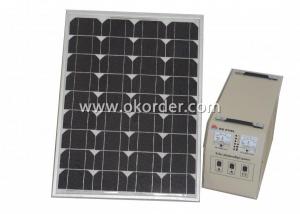Sirus Solar Energy Systems Pure Sine Wave Solar Inverter 300W High Efficiency 12V/24V/36V/48V Input
- Loading Port:
- Qingdao
- Payment Terms:
- TT or LC
- Min Order Qty:
- 1 pc
- Supply Capability:
- 800 pc/month
OKorder Service Pledge
OKorder Financial Service
You Might Also Like
Specifications
1.Pure sine wave output(<2%THD)
2.High Efficiency 87%-90%
3.High motor start driven force
4.Function of battery protection
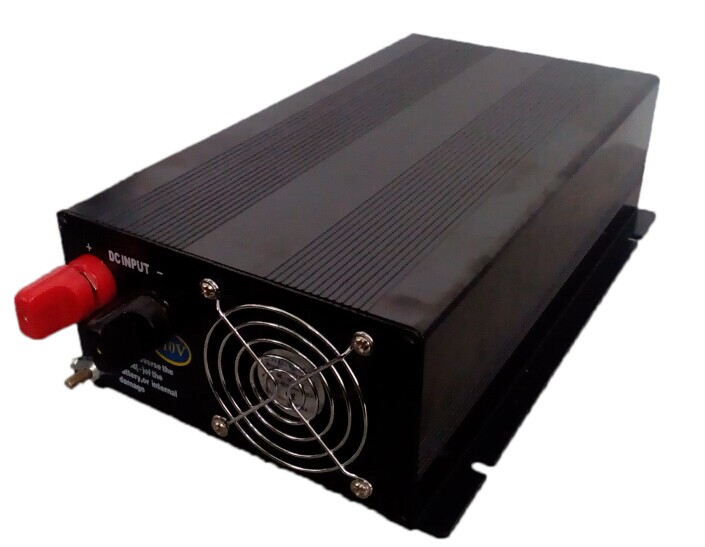
Product characteristic:
1.Pure sine wave output(<2%thd)< span="">
2.Input & Output fully isolation design
3.High Efficiency 87%-90%
4.High motor start driven force
5.5-stage thermal control fan
6.Function of battery protection
Technical Parameters:
Model | DMS300-12 | DMS300-24 | DMS300-36 | DMS300-48 |
Continuous output power | 300W | 300W | 300W | 300W |
Max power output | 320W | 320W | 320W | 320W |
Peak instantaneous power | 600W | 600W | 600W | 600W |
Conversion efficiency | ≥87% | |||
No -load current | 0.65A | 0.33A | 0.22A | 0.17A |
Output AC Voltage | 220/230/240/110/120/130V +5% | |||
Output wave form | Sine wave < 2%THD | |||
Frequency output | 50/60Hz+2% | |||
Input Dc Voltage | 10-16VDC | 20-30VDC | 30-45VDC | 40-60VDC |
Fault display | Red lamp flickers and buzzer alarms | |||
Working temperature | -20~55°C | |||
Function of protection | Alarm and protection in over loading, over voltage, low voltage, short circuit, over heating and converse connection, etc. | |||
Fan | Thermal control | |||
Product measurement(mm) | 265*140*81 | |||
Pack measurement(mm) | 340*165*140 | |||
Net weight | 2.6Kg | |||
Gross weight | 2.8Kg | |||
Application:
Electric tools:fretsaws, drills, mullers, grinder wheels, mowers, air compressors, etc.
Office equipment:computer, facsimile machines, scanners, etc.
Kitchen appliances:microwave oven, refrigerators, blenders, soybean juice machine, coffee makers, ovens, etc.
Lighting instruments: high pressure sodium lamp, compact fluorescent light, daylight lamp, halogen light, etc.
Home entertainment electronics:TV, blower, vacuum cleaners, fans, video games, musical instrument, charger, etc.
Payment Terms:
T/T, West Union,Money Gram, Paypal
Express Delivery:
EMS, DHL, FedEx, TNT, UPS
FAQ:
Q1:Can we visit your factory?
A1:Sure,welcome at any time,seeing is believing.
Q2:Which payment terms can you accept?
A2:T/T,L/C,Moneygram,Paypal are available for us.
- Q: What is the role of solar energy systems in promoting energy independence?
- Solar energy systems play a crucial role in promoting energy independence by providing a reliable and renewable source of power. By harnessing the sun's energy, these systems reduce our dependence on fossil fuels and foreign energy sources. They allow individuals, communities, and even entire countries to generate their own electricity, reducing the need for traditional power grids and increasing self-sufficiency. Solar energy systems empower individuals to take control of their energy consumption and contribute to a more sustainable and independent future.
- Q: Can solar energy systems be used in areas with limited access to emergency services?
- Yes, solar energy systems can be used in areas with limited access to emergency services. Solar energy systems are independent and self-sufficient, requiring minimal maintenance and intervention. They can provide electricity for various purposes, including powering emergency communication devices, lighting, and medical equipment. Additionally, solar energy systems can reduce reliance on traditional energy sources, making them a reliable and sustainable option for areas with limited access to emergency services.
- Q: How do solar energy systems affect wildlife and ecosystems?
- Solar energy systems have minimal negative impacts on wildlife and ecosystems compared to other forms of energy generation. While the construction and operation of solar farms may disrupt local habitats temporarily, they generally have a smaller footprint and lower emissions than fossil fuel power plants. Proper planning and siting can help mitigate potential effects on wildlife, and studies have shown that solar farms can even provide new habitats for certain species. Overall, solar energy systems have a relatively positive environmental profile and contribute to the conservation of wildlife and ecosystems.
- Q: Can solar energy systems be used for water desalination?
- Yes, solar energy systems can be used for water desalination. Solar-powered desalination systems use solar energy to power the desalination process, which removes salt and other impurities from seawater or brackish water to make it suitable for drinking or irrigation purposes. These systems typically utilize solar panels to convert sunlight into electricity, which is then used to power the desalination process, such as reverse osmosis or distillation. By harnessing the renewable energy of the sun, solar-powered desalination offers a sustainable and environmentally friendly solution to address water scarcity issues in coastal regions.
- Q: Can solar panels be installed on floating platforms or buoys in bodies of water?
- Yes, solar panels can be installed on floating platforms or buoys in bodies of water. Floating solar, also known as floating photovoltaic (FPV) systems, are becoming increasingly popular due to their numerous advantages such as increased energy production, reduced land usage, and minimized water evaporation. These platforms or buoys are designed to withstand water conditions and can be installed in lakes, reservoirs, and even offshore.
- Q: Can solar energy systems be used in areas with frequent lightning strikes?
- Yes, solar energy systems can be used in areas with frequent lightning strikes. While lightning strikes can pose a risk to any electrical system, including solar panels, there are measures in place to mitigate this risk. Solar panels are designed to withstand various weather conditions, including lightning strikes. They are built to be durable and capable of handling external stressors, such as electrical surges caused by lightning. Additionally, solar panels are grounded using lightning protection systems to divert the electrical charge safely into the ground, reducing the risk of damage to the system. Furthermore, solar energy systems typically include surge protection devices and lightning arresters that help dissipate and redirect electrical surges caused by lightning strikes. These protective measures help safeguard the system and prevent any potential damage. It is important to note that while solar energy systems can generally withstand lightning strikes, it is still recommended to consult with a professional installer and follow local electrical codes and regulations to ensure proper installation and protection against lightning strikes.
- Q: How do solar energy systems impact the structural integrity of a building?
- Solar energy systems can have a minimal impact on the structural integrity of a building. The installation of solar panels requires proper planning and engineering to ensure that the additional weight and any penetrations made do not compromise the building's structure. When installed correctly, solar energy systems can actually provide additional support and protection to the roof, making it more durable and extending its lifespan.
- Q: Can solar energy systems be easily expanded or upgraded?
- Yes, solar energy systems can be easily expanded or upgraded. The modular nature of solar panels allows for additional panels to be added to the system, increasing its capacity. Similarly, if more energy is required, additional batteries can be installed to store excess energy. Furthermore, advancements in technology and increasing efficiency of solar panels make it possible to upgrade existing systems with new and more efficient components, improving overall performance.
- Q: Are there any insurance requirements for installing a solar energy system?
- Yes, there are insurance requirements for installing a solar energy system. While the specific requirements may vary depending on the location and individual circumstances, it is generally recommended to have appropriate insurance coverage in place when installing a solar energy system. This is important as it helps protect your investment and provides financial security in case of any unexpected damages or accidents. One of the most common insurance requirements for solar energy systems is property insurance. This covers any damage or loss to the physical components of the system, such as solar panels, inverters, and batteries. Property insurance typically protects against risks like fire, theft, vandalism, and natural disasters. Additionally, liability insurance is often necessary when installing a solar energy system. This coverage helps protect you from potential legal claims arising from accidents or injuries that may occur during the installation or operation of the system. Liability insurance may also provide coverage for any damage caused to neighboring properties. In some cases, if you are financing your solar energy system through a loan or lease, the lender or leasing company may require specific insurance coverage as a condition of the agreement. These requirements may include certain coverage limits, additional insured endorsements, or even specific insurance providers. It is important to consult with your insurance provider and solar installer to ensure that you have the appropriate insurance coverage in place before installing a solar energy system. They will be able to guide you through any specific requirements or recommendations based on your location and individual circumstances.
- Q: How do solar energy systems impact the grid?
- Solar energy systems impact the grid by injecting clean and renewable energy into the system, reducing the overall demand for fossil fuel-based electricity. This helps to decrease greenhouse gas emissions and promote a more sustainable and environmentally friendly energy sector. However, solar energy systems also present challenges for grid operators due to their intermittent nature, as they only produce electricity when the sun is shining. Grid integration and management strategies are required to balance the variations in solar energy generation and ensure grid stability and reliability.
Send your message to us
Sirus Solar Energy Systems Pure Sine Wave Solar Inverter 300W High Efficiency 12V/24V/36V/48V Input
- Loading Port:
- Qingdao
- Payment Terms:
- TT or LC
- Min Order Qty:
- 1 pc
- Supply Capability:
- 800 pc/month
OKorder Service Pledge
OKorder Financial Service
Similar products
Hot products
Hot Searches
Related keywords
